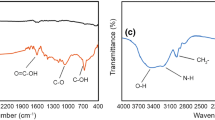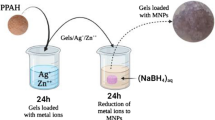Abstract
In this study, Cu-doped ZnO NPs (xCZO) were formed by the coprecipitation route by changing the concentration of dopant Cu from 0 to 24% (w/w). Cu-doped ZnO nanocomposite with polyacrylamide microgel (PAM) was formed by incorporating xCZO NPs into the PAM microgel. The xCZO NP and xCZO/PAM nanocomposites were used for methyl blue (MB) dye degradation and disinfection under solar light. Among the xCZO NPs, 18% Cu-doped ZnO (18CZO) showed excellent MB degradation under solar light. So, 18CZO NPs were used for the formation of nanocomposite with PAM microgel which further enhanced the dye degradation rate due to high surface area and PAM microgel adsorption ability. 18CZO/PAM nanocomposite showed good cyclic stability, checked up to 5 cycles.








Similar content being viewed by others
Data availability
The datasets generated during and/or analyzed during the current study are available from the corresponding author on reasonable request.
References
K. Karthik et al., Green synthesis of Cu-doped ZnO nanoparticles and its application for the photocatalytic degradation of hazardous organic pollutants. Chemosphere 287, 132081 (2022)
V. Shanmugam, K.S. Jeyaperumal, Investigations of visible light driven Sn and Cu doped ZnO hybrid nanoparticles for photocatalytic performance and antibacterial activity. Appl. Surf. Sci. 449, 617–630 (2018)
Iqbal, S., et al., Design Ag-doped ZnO heterostructure photocatalyst with sulfurized graphitic C3N4 showing enhanced photocatalytic activity. Materials Science and Engineering: B, 2021. 272: p. 115320.
H.R. Khan et al., Photocatalytic removal of carcinogenic reactive red S3B dye by using ZnO and Cu doped ZnO nanoparticles synthesized by polyol method: a kinetic study. Sol. Energy 173, 875–881 (2018)
D. Toloman et al., Visible-light-driven photocatalytic degradation of different organic pollutants using Cu doped ZnO-MWCNT nanocomposites. J. Alloys Comp. 866, 159010 (2021)
Muhammad Irfan, R., et al., CoSe as Non-Noble-Metal Cocatalyst Integrated with Heterojunction Photosensitizer for Inexpensive H2 Production under Visible Light. Journal of Catalysis, 2020.
B.K. Mahajan et al., Mechanistic evaluation of heterocyclic aromatic compounds mineralization by a Cu doped ZnO photo-catalyst. Photochem. Photobiol. Sci. 18(6), 1540–1555 (2019)
K.V. Chandekar et al., Visible light sensitive Cu doped ZnO: facile synthesis, characterization and high photocatalytic response. Mater. Charact. 165, 110387 (2020)
S. Iqbal et al., Controlled synthesis of Ag-doped CuO nanoparticles as a core with poly (acrylic acid) microgel shell for efficient removal of methylene blue under visible light. J. Mater. Sci.: Mater. Electron. 31(11), 8423–8435 (2020)
M.A. Qamar et al., Fabrication of g-C3N4/transition metal (Fe Co, Ni, Mn and Cr)-doped ZnO ternary composites: excellent visible light active photocatalysts for the degradation of organic pollutants from wastewater. Mater. Res. Bull. 147, 111630 (2022)
W. Hussain et al., Synthesis of MnS from single- and multi-source precursors for photocatalytic and battery applications. J. Electron. Mater. 48(4), 2278–2288 (2019)
V. Barahimi, H. Moghimi, R.A. Taheri, Cu doped TiO2-Bi2O3 nanocomposite for degradation of azo dye in aqueous solution: process modeling and optimization using central composite design. J. Environ. Chem. Eng. 7(3), 103078 (2019)
N.T. Hanh et al., Monocrotophos pesticide effectively removed by novel visible light driven Cu doped ZnO photocatalyst. J. Photochem. Photobiol. A Chem. 382, 11923 (2019)
V. Vaiano, G. Iervolino, L. Rizzo, Cu-doped ZnO as efficient photocatalyst for the oxidation of arsenite to arsenate under visible light. Appl. Catal. B 238, 471–479 (2018)
M. Rashid et al., Photocatalytic, dye degradation, and bactericidal behavior of Cu-doped ZnO nanorods and their molecular docking analysis. Dalton Trans. 49(24), 8314–8330 (2020)
A. Bahadur et al., Modulating the burst drug release effect of waterborne polyurethane matrix by modifying with polymethylmethacrylate. J. Appl. Polym. Sci. 136(13), 47253 (2019)
M. Shoaib et al., Sustained drug delivery of doxorubicin as a function of pH, releasing media, and NCO contents in polyurethane urea elastomers. J. Drug Deliv. Sci. Technol. 39, 277–282 (2017)
F. Raziq et al., Synthesis of SnO2/BP codoped g-C3N4 nanocomposites as efficient cocatalyst-free visible-light photocatalysts for CO2 conversion and pollutant degradation. Appl. Catal. B Environ. 201, 486–494 (2017)
S.A. Khan et al., Green synthesis of ZnO and Cu-doped ZnO nanoparticles from leaf extracts of Abutilon indicum, Clerodendrum infortunatum, Clerodendrum inerme and investigation of their biological and photocatalytic activities. Mater. Sci. Eng. C 82, 46–59 (2018)
A. Zada et al., Exceptional visible-light-driven cocatalyst-free photocatalytic activity of g-C3N4 by well designed nanocomposites with plasmonic Au and SnO2. Adv. Energy Mater. 6(21), 1601190 (2016)
F. Raziq et al., Photocatalytic solar fuel production and environmental remediation through experimental and DFT based research on CdSe-QDs-coupled P-doped-g-C3N4 composites. Appl. Catal. B Environ. 270, 118867 (2020)
N.T.T. Truc et al., The advanced photocatalytic degradation of atrazine by direct Z-scheme Cu doped ZnO/g-C3N4. Appl. Surf. Sci. 489, 875–882 (2019)
S. Iqbal et al., Synthesis of Cu–ZnO/polyacrylic acid hydrogel as visible-light-driven photocatalyst for organic pollutant degradation. ChemistrySelect (2022). https://doi.org/10.1002/slct.202103694
S. Iqbal et al., Green synthesis of biodegradable terpolymer modified starch nanocomposite with carbon nanoparticles for food packaging application. J. Appl. Polym. Sci. 138(25), 50604 (2021)
S. Iqbal et al., The effect of Ni-doped ZnO NPs on the antibacterial activity and degradation rate of polyacrylic acid-modified starch nanocomposite. JOM 73(1), 380–386 (2021)
S. Iqbal et al., Designing novel morphologies of l-cysteine surface capped 2D covellite (CuS) nanoplates to study the effect of CuS morphologies on dye degradation rate under visible light. CrystEngComm 22(24), 4162–4173 (2020)
S. Iqbal et al., Critical role of the heterojunction interface of silver decorated ZnO nanocomposite with sulfurized graphitic carbon nitride heterostructure materials for photocatalytic applications. J. Alloys Compd. (2021). https://doi.org/10.1016/j.jallcom.2020.158338
M. Mittal, M. Sharma, O.P. Pandey, UV–Visible light induced photocatalytic studies of Cu doped ZnO nanoparticles prepared by co-precipitation method. Sol. Energy 110, 386–397 (2014)
X.-Y. Li et al., Influence of oxygen partial pressure on electrical and optical properties of Zn0.93Mn0.07O thin films. J. Alloys Compd. 509(6), 3025–3031 (2011)
S. Iqbal et al., Synthesis of Cu-ZnO/polyacrylic acid hydrogel as visible-light-driven photocatalyst for organic pollutant degradation. ChemistrySelect 7(1), e202103694 (2022)
M. Sher et al., The controlled synthesis of g-C3N4/Cd-doped ZnO nanocomposites as potential photocatalysts for the disinfection and degradation of organic pollutants under visible light irradiation. RSC Adv. 11(4), 2025–2039 (2021)
M. Sher et al., Designing of highly active g-C3N4/Sn doped ZnO heterostructure as a photocatalyst for the disinfection and degradation of the organic pollutants under visible light irradiation. J. Photochem. Photobiol. A Chem. 418, 113393 (2021)
M. Xu et al., Designed synthesis of microstructure and defect-controlled Cu-doped ZnO–Ag nanoparticles: exploring high-efficiency sunlight-driven photocatalysts. J. Phys. D: Appl. Phys. 53(2), 025106 (2019)
M.A. Qamar et al., Designing of highly active g-C3N4/Ni-ZnO photocatalyst nanocomposite for the disinfection and degradation of the organic dye under sunlight radiations. Colloids Surf. A: Physicochem. Eng. Aspects 614, 126176 (2021)
M.A. Qamar et al., Highly efficient g-C3N4/Cr-ZnO nanocomposites with superior photocatalytic and antibacterial activity. J. Photochem. Photobiol. A: Chem. 401, 112776 (2020)
A.P. Khandhar et al., Physicochemical structure of a polyacrylic acid stabilized nanoparticle alum (nanoalum) adjuvant governs TH1 differentiation of CD4+ T cells. Nanoscale 12(4), 2515–2523 (2020)
A. Bahadur et al., Designing a novel visible-light-driven heterostructure Ni–ZnO/S-g-C3N4 photocatalyst for coloured pollutant degradation. RSC Adv. 11(58), 36518–36527 (2021)
M. Shirzad-Siboni et al., Enhancement of photocatalytic activity of Cu-doped ZnO nanorods for the degradation of an insecticide: kinetics and reaction pathways. J. Environ. Manage. 186, 1–11 (2017)
M.A. Qamar et al., Designing of highly active g-C3N4/Co@ZnO ternary nanocomposites for the disinfection of pathogens and degradation of the organic pollutants from wastewater under visible light. J. Environ. Chem. Eng. 9(4), 105534 (2021)
R. Kannaujia et al., Facile synthesis of CuFe2O4 doped polyacrylic acid hydrogel nanocomposite and its application in dye degradation. Mater. Lett. 252, 198–201 (2019)
H.P. Mota et al., Enhanced photocatalytic degradation of organic pollutants mediated by Zn(II)-porphyrin/poly(acrylic acid) hybrid microparticles. Appl. Catal. B: Environ. 277, 119208 (2020)
Acknowledgements
Taif University Researchers Supporting Project number (TURSP-2020/00), Taif University, Taif, Saudi Arabia. The authors acknowledge the support provided by the Guangdong Education Department's Key Projects (2021ZDJS081), the National Key R&D Program of China (Grant No. 2019YFE0112500), National Natural Science Foundation of China (Grant No. 51978185), and Program for Changjiang Scholars and Innovative Research Team in University (Grant No. IRT13057).
Author information
Authors and Affiliations
Contributions
CK involved in analysis and/or interpretation of data, performed some photocatalysis experiments, and reviewed revised manuscript and critical revision. PT conducted FTIR analysis and reviewed revised manuscript and critical revision. AB conducted SEM and XPS analyses and performed acquisition of data, and writing-original draft preparation. SI participated in conception, design of the study and performed major experimental works, writing-original draft preparation, and supervision. MJ drafted the original manuscript and contributed to supervision and acquisition of data. MAQ conducted XRD analysis and performed some photocatalytic experiments, acquisition of data, and writing-original draft preparation. MF performed photocatalysis experiments and acquisition of the data. GL interpreted the revised data and helped a lot in revising the manuscript and supervision. OMA took part in analysis and/or interpretation of the data and performed FTIR analysis. EA conducted some photocatalysis experiments, reviewed revised manuscript, and performed critical revision. AEF drafted the original manuscript and involved in acquisition of data, reviewing revised manuscript, and critical revision.
Corresponding authors
Ethics declarations
Conflict of interest
The authors declare that they have no conflict of interest.
Additional information
Publisher's Note
Springer Nature remains neutral with regard to jurisdictional claims in published maps and institutional affiliations.
Supplementary Information
Below is the link to the electronic supplementary material.
Rights and permissions
About this article
Cite this article
Kuang, C., Tan, P., Bahadur, A. et al. Dye degradation study by incorporating Cu-doped ZnO photocatalyst into polyacrylamide microgel. J Mater Sci: Mater Electron 33, 9930–9940 (2022). https://doi.org/10.1007/s10854-022-07984-6
Received:
Accepted:
Published:
Issue Date:
DOI: https://doi.org/10.1007/s10854-022-07984-6




